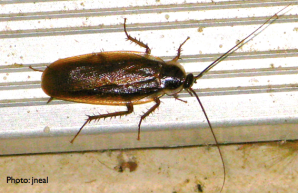
Cockroach Darkens a Doorstep
Insects can detect differences in humidity. This enables insects to locate in microclimates that have adequate moisture to prevent desiccation. The cockroach,
Periplaneta americana, has hygroreceptors on its antennae that respond to humidity. Humidity receptors consist of three nerve cells: a wet cell, a dry cell and a cold cell packed into a sensillum. The wet cell increases activity when humidity increases and decreases activity when humidity decreases. The dry cell does the opposite. It decreases activity when humidity increases and increases activity when humidity decreases. The cold cell is a reference and does not respond to humidity. The difference in activity between the wet cell and the dry cell could be used as an indicator of humidity. What stimulates these cells? Several models have been proposed including an evaporation detection model and mechanical model and a psychrometer model.
Harald Tichy and Wolfgang Kallina provide evidence* for how the receptors measure humidity. Evaporation of water from a surface takes heat from the surface cooling the surface. In high humidity, less water evaporates and the surface of the receptor is warmer. In low humidity more water evaporates and the surface is cooler. The wet cell and the dry cell respond to the change in temperature. Thus a cockroach humidity receptor appears to work on the same principle as a psychrometer.
*Tichy H, Kallina W (2013) The Evaporative Function of Cockroach Hygroreceptors. PLoS ONE 8(1): e53998.
doi:10.1371/journal.pone.0053998
About jjneal
Jonathan Neal is a retired Associate Professor of Entomology at Purdue University and author of the textbook, Living With Insects (2010).
This blog is a forum to communicate about the intersection of insects with people and policy. This is a personal blog.
The opinions and materials posted here are those of the author and are in no way connected with those of my employer.


Pingback: Friday Cat-erpillar Blogging: Monitoring Humidity | Living With Insects Blog